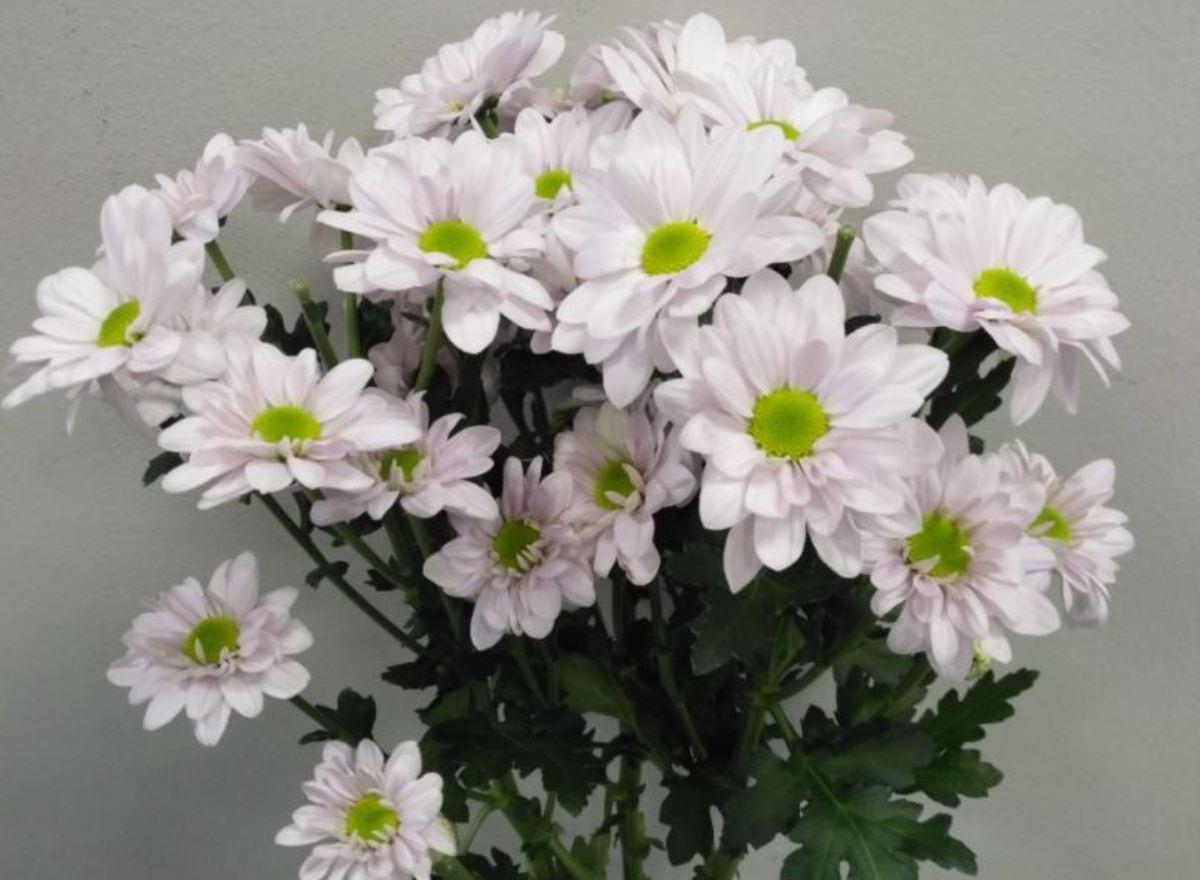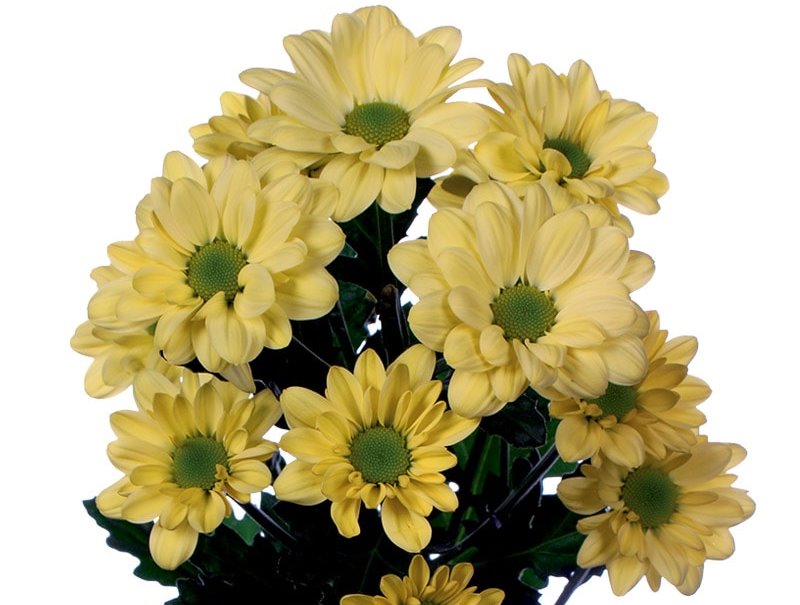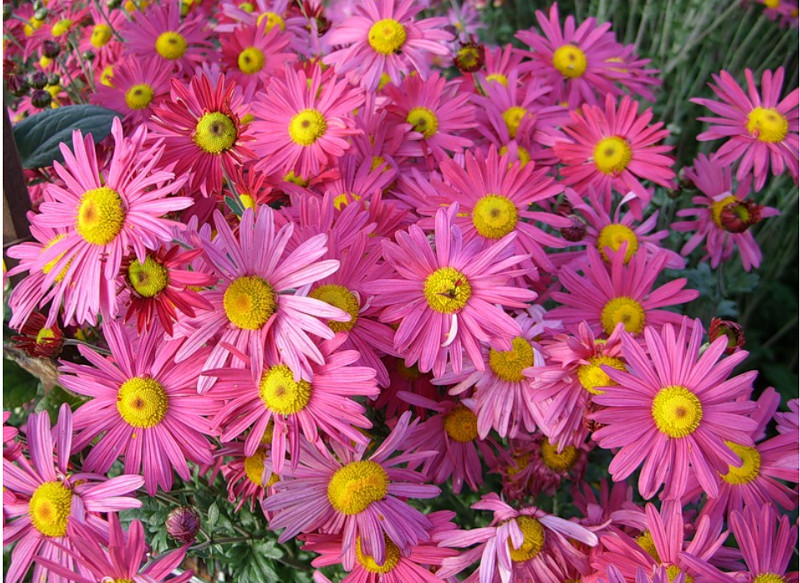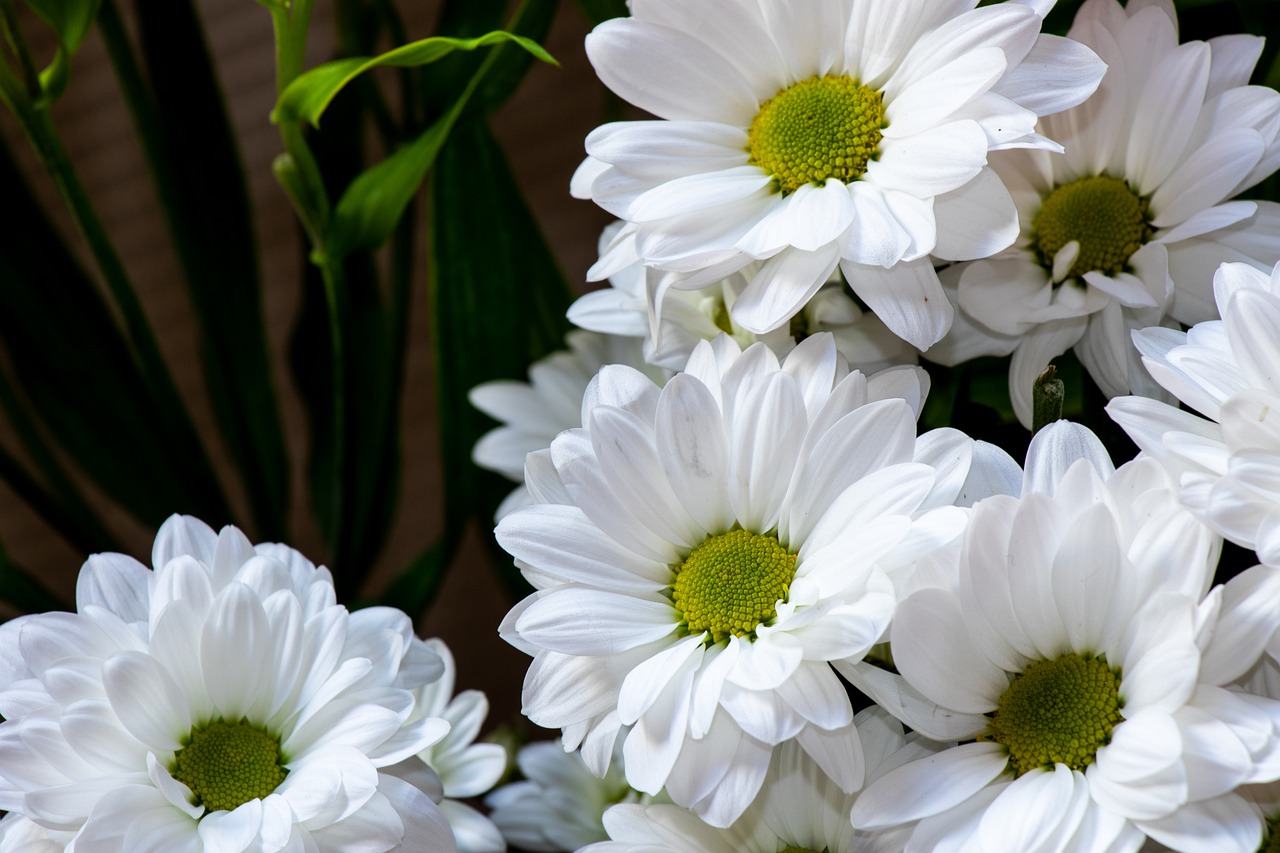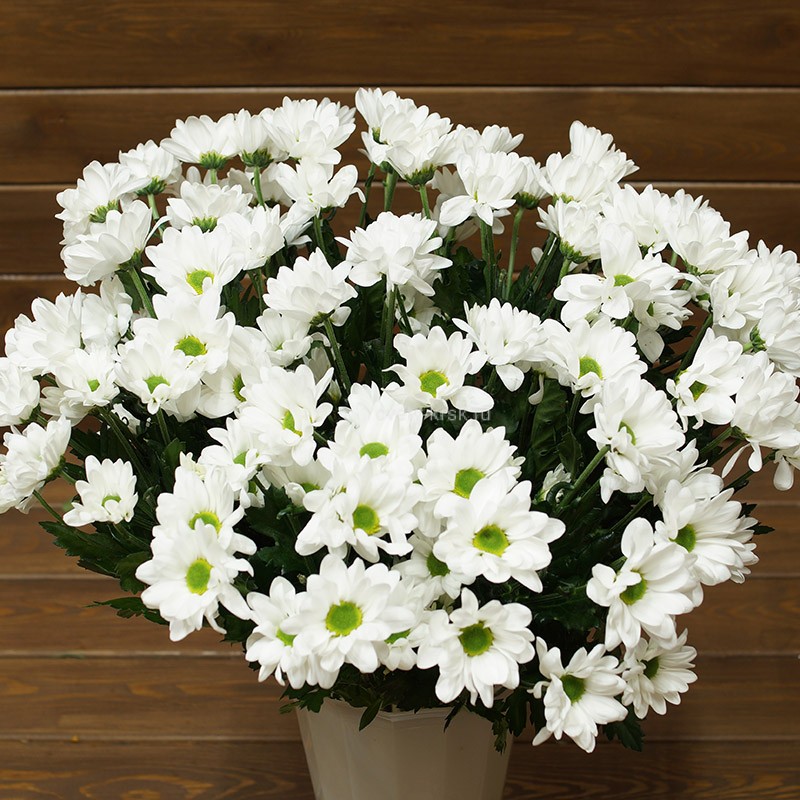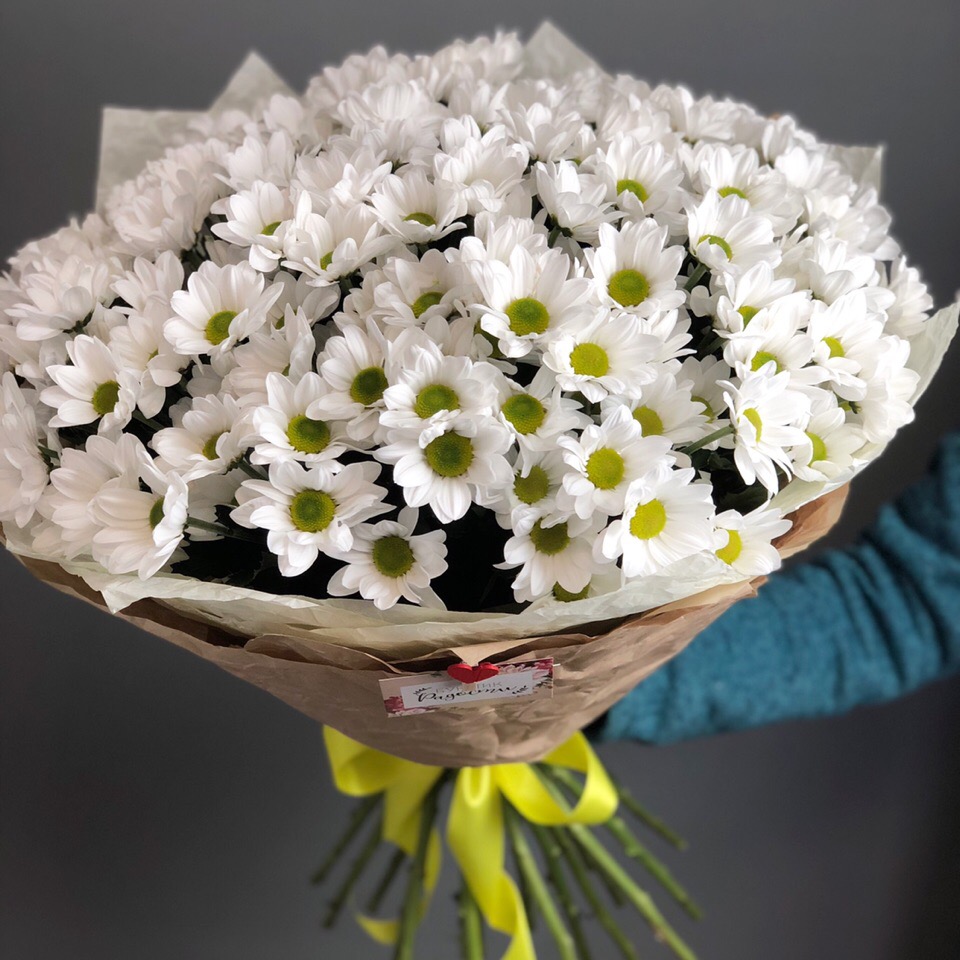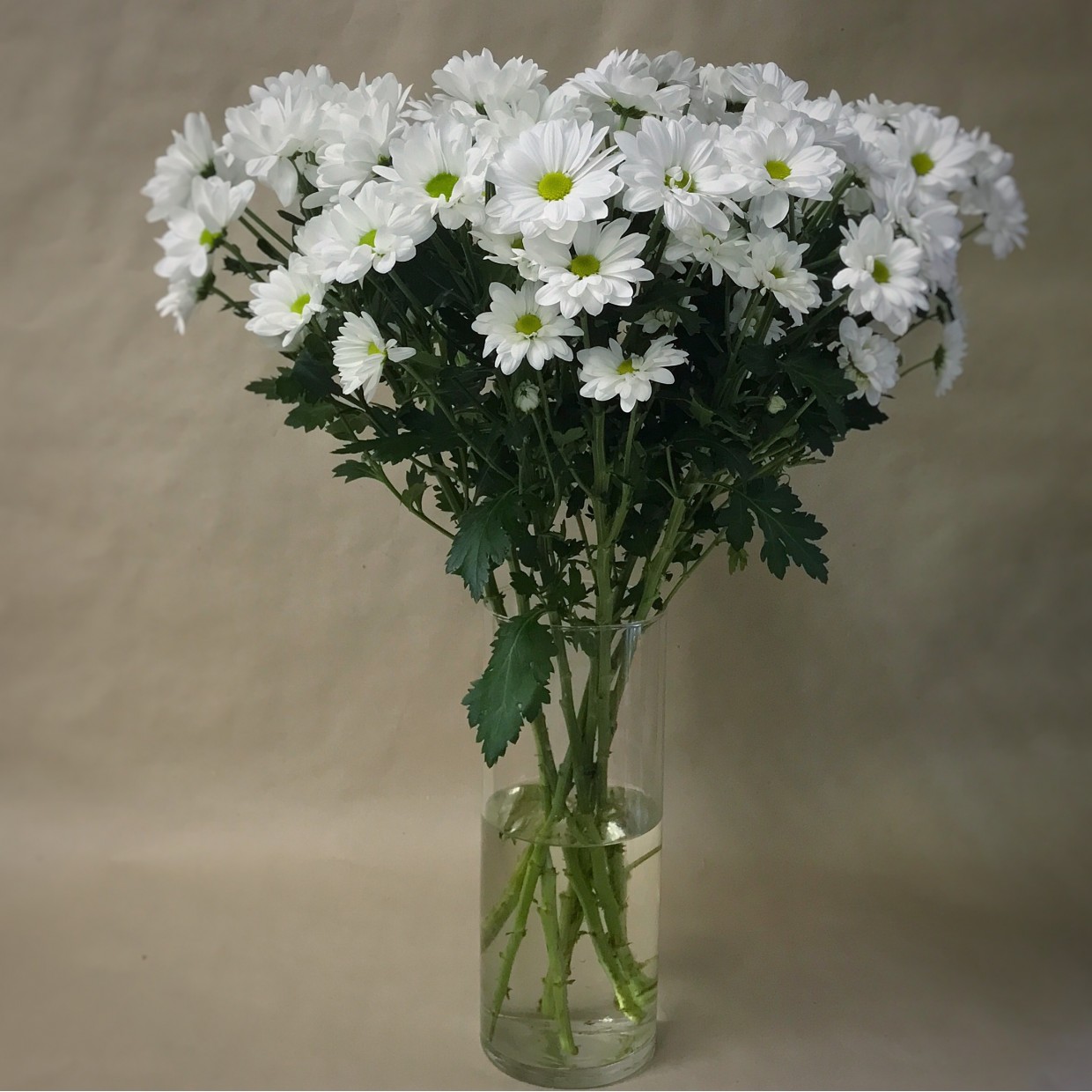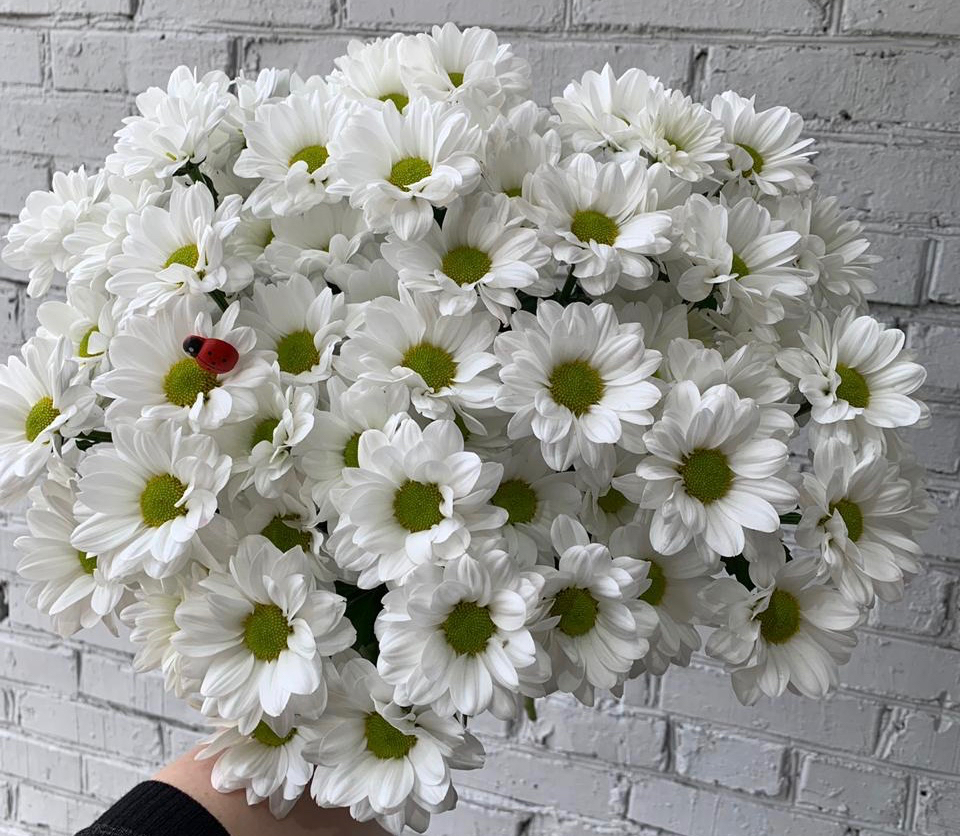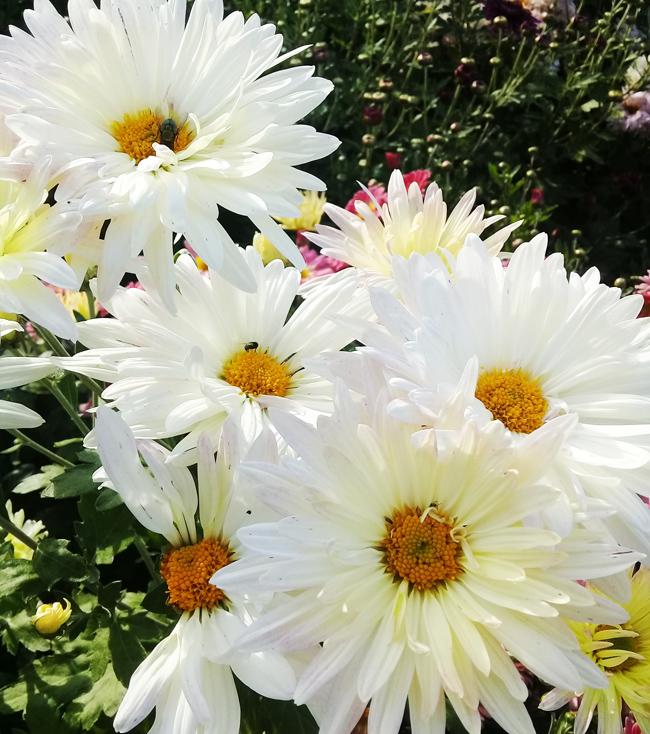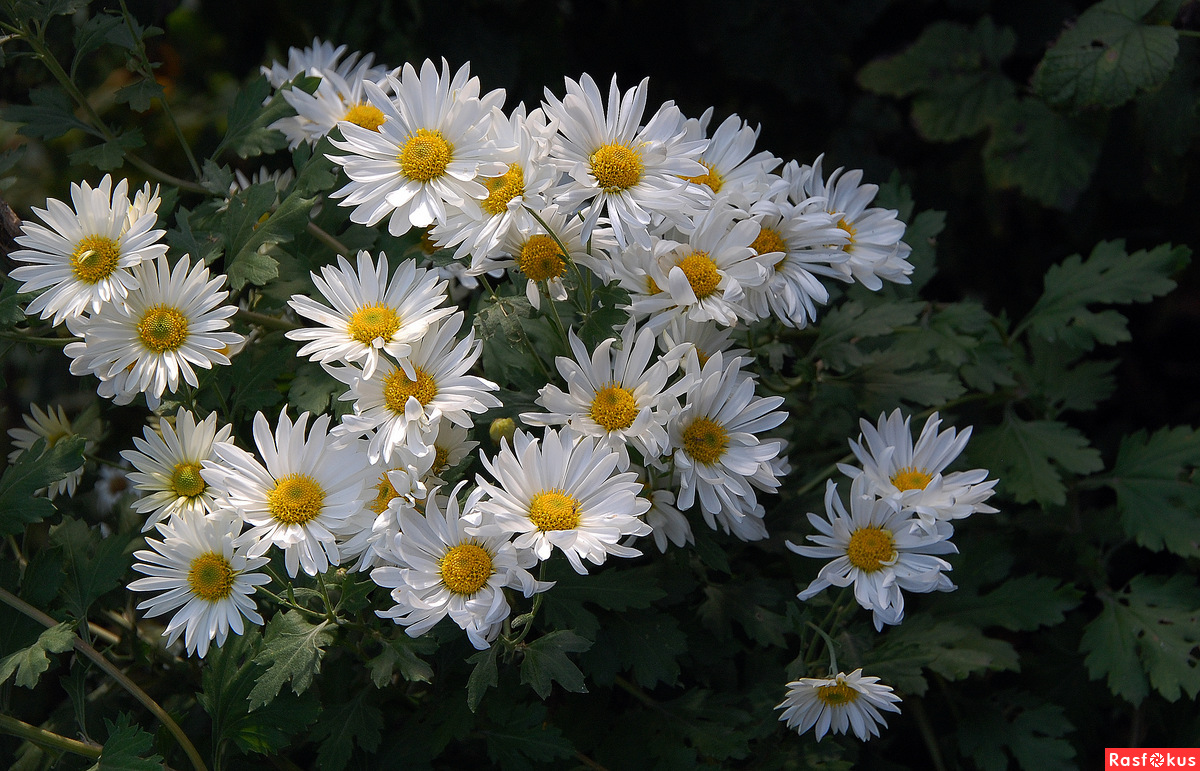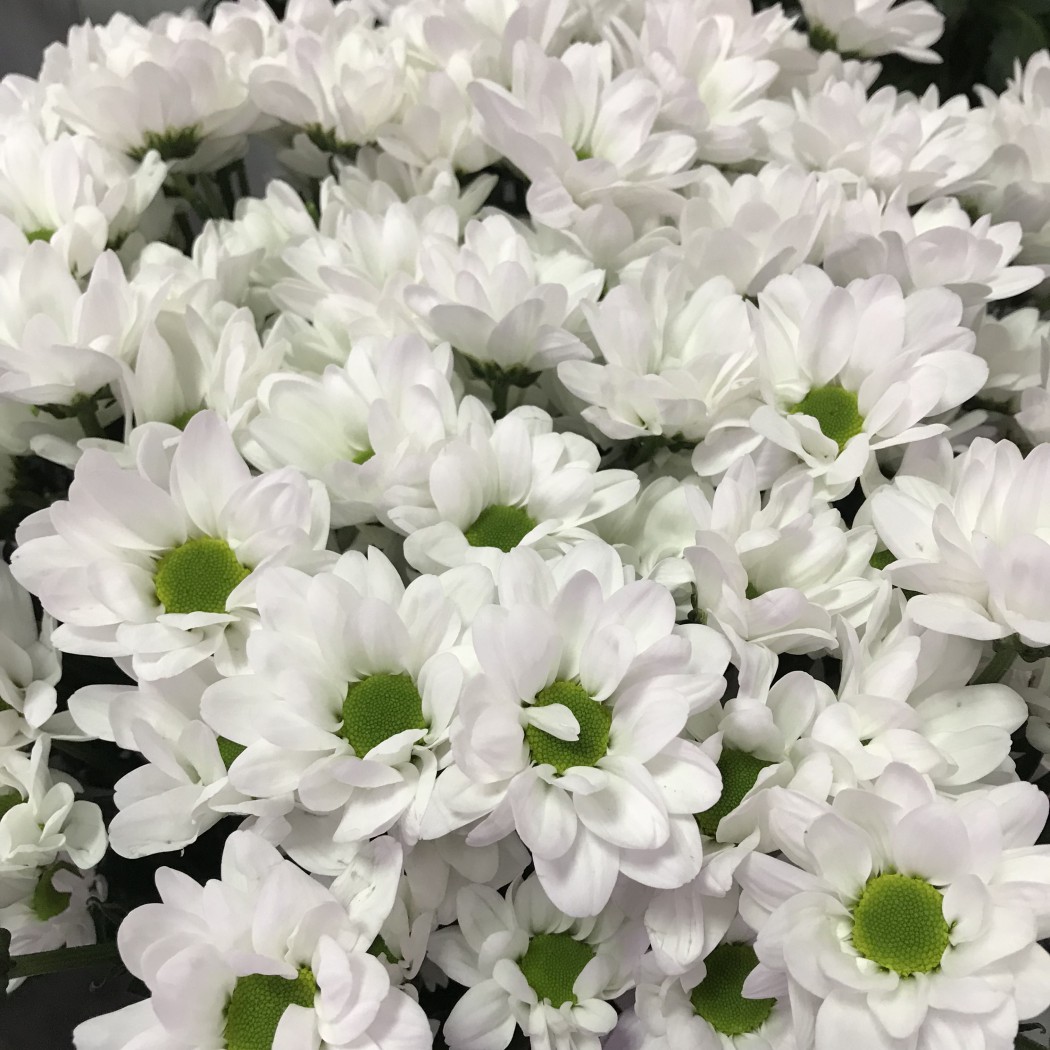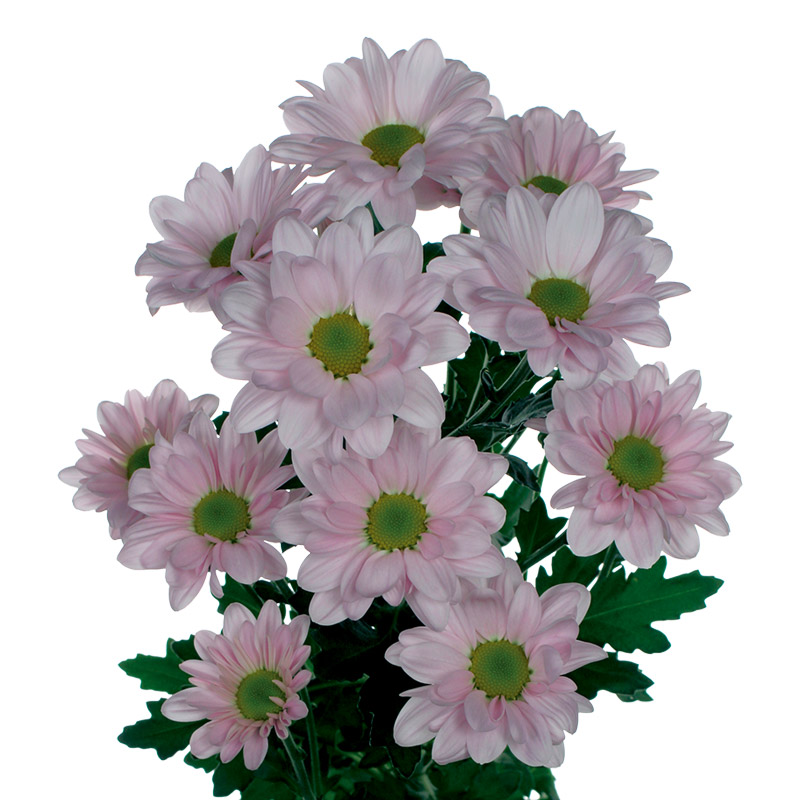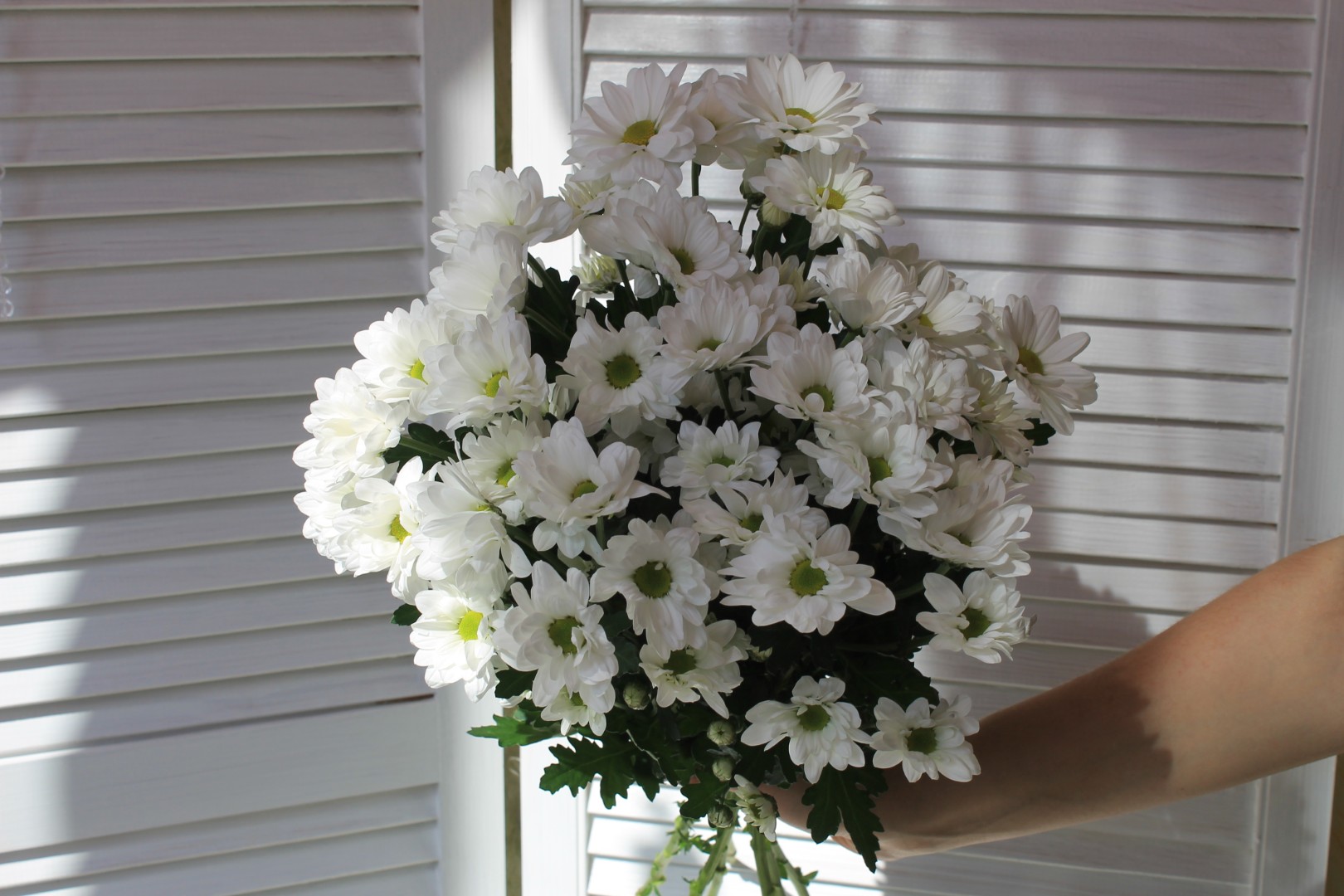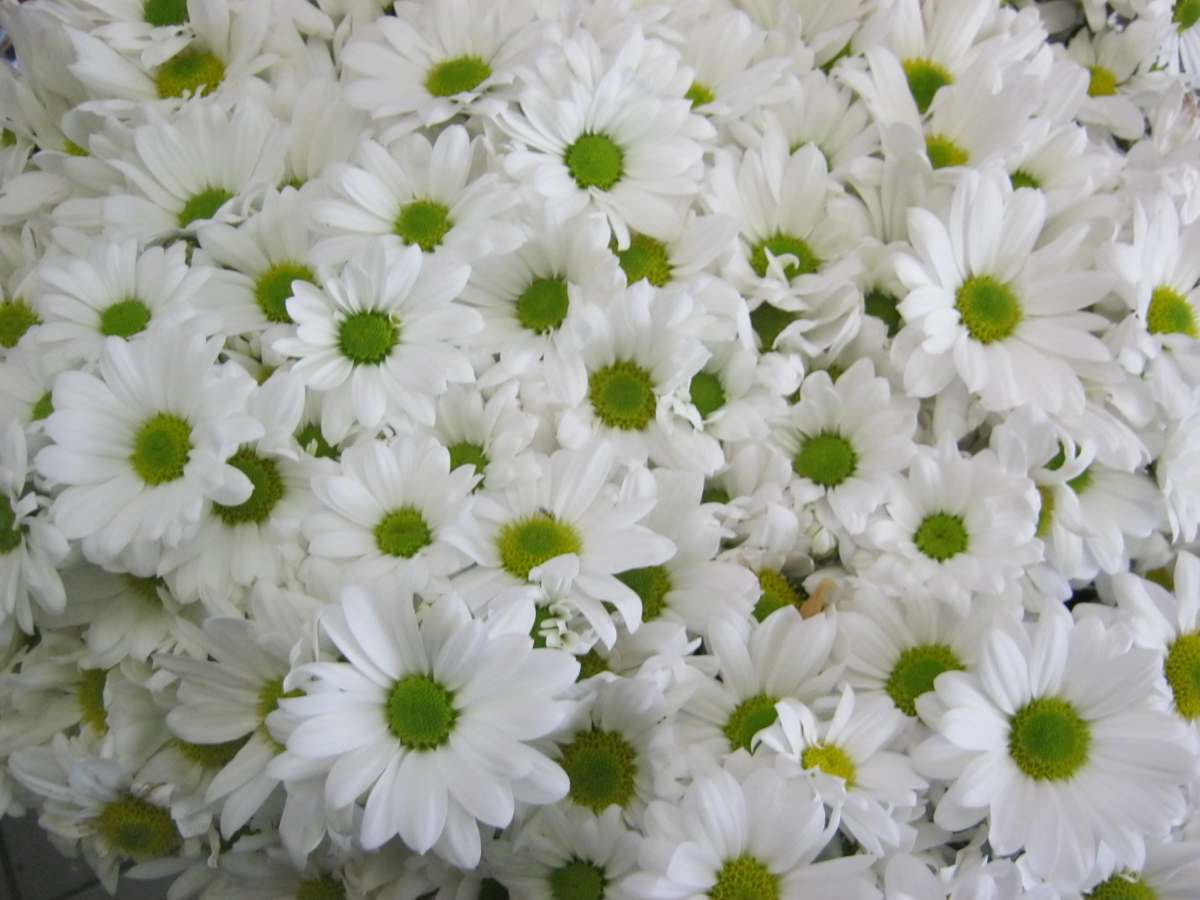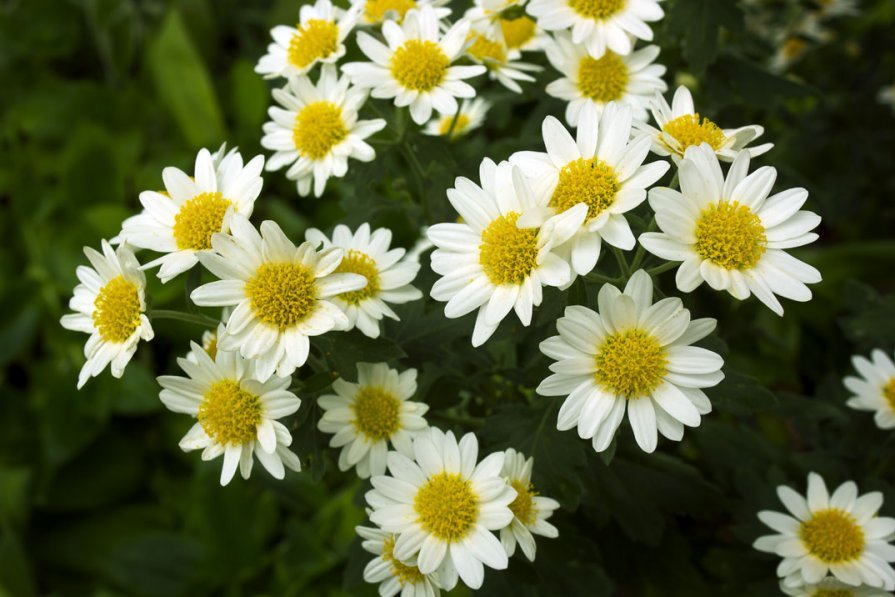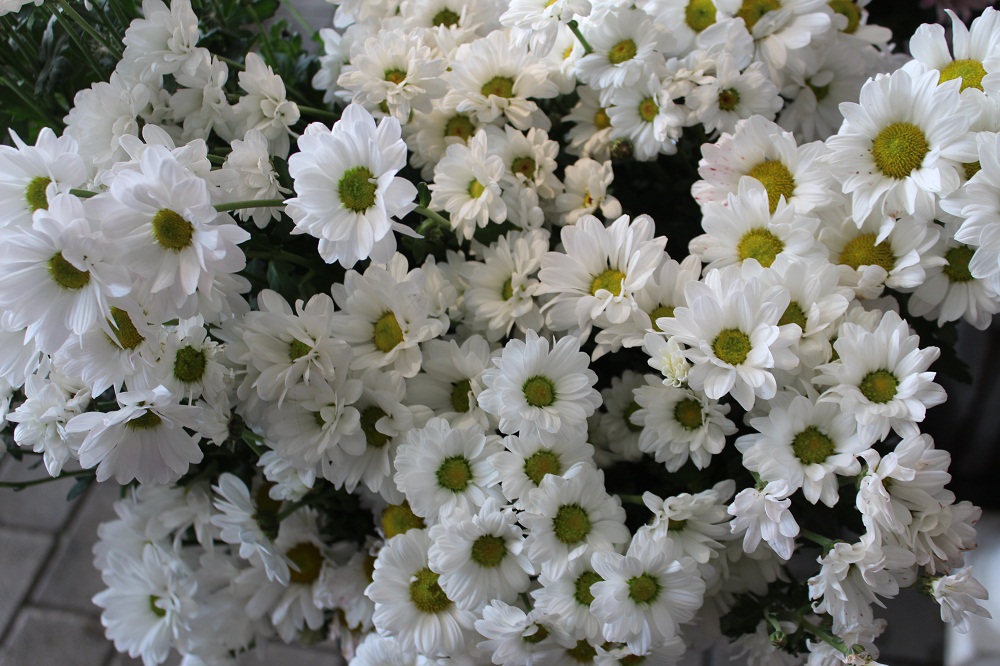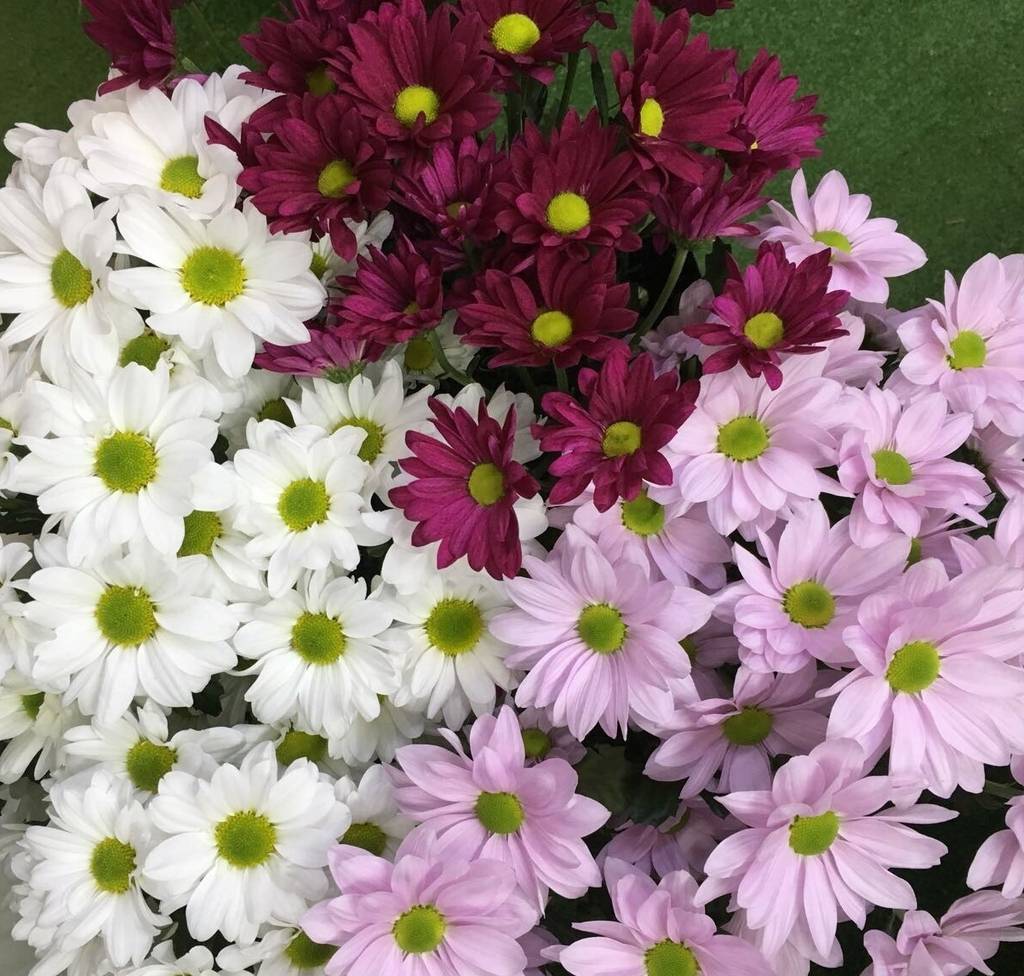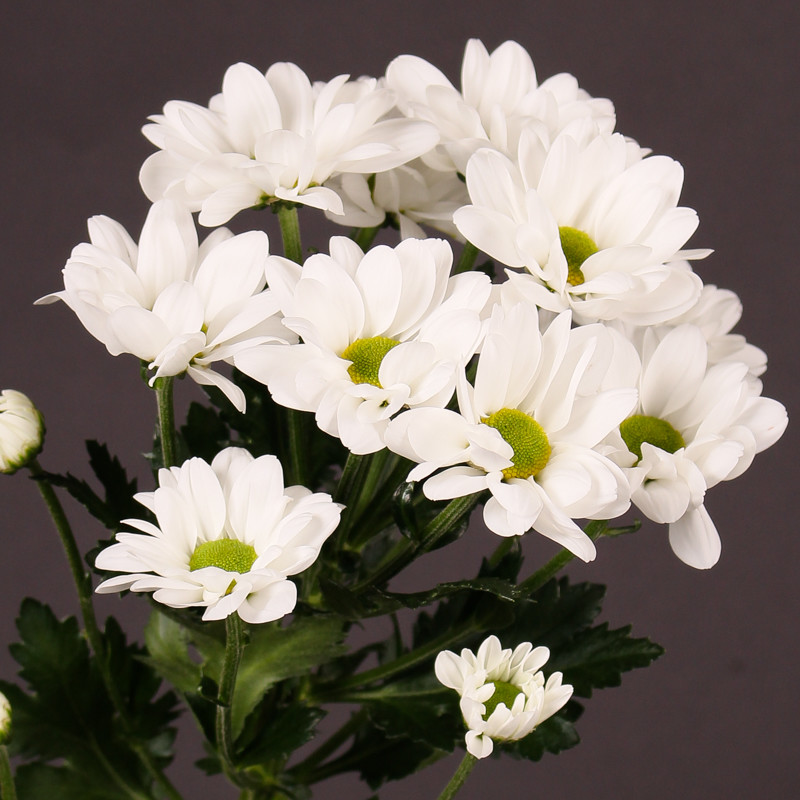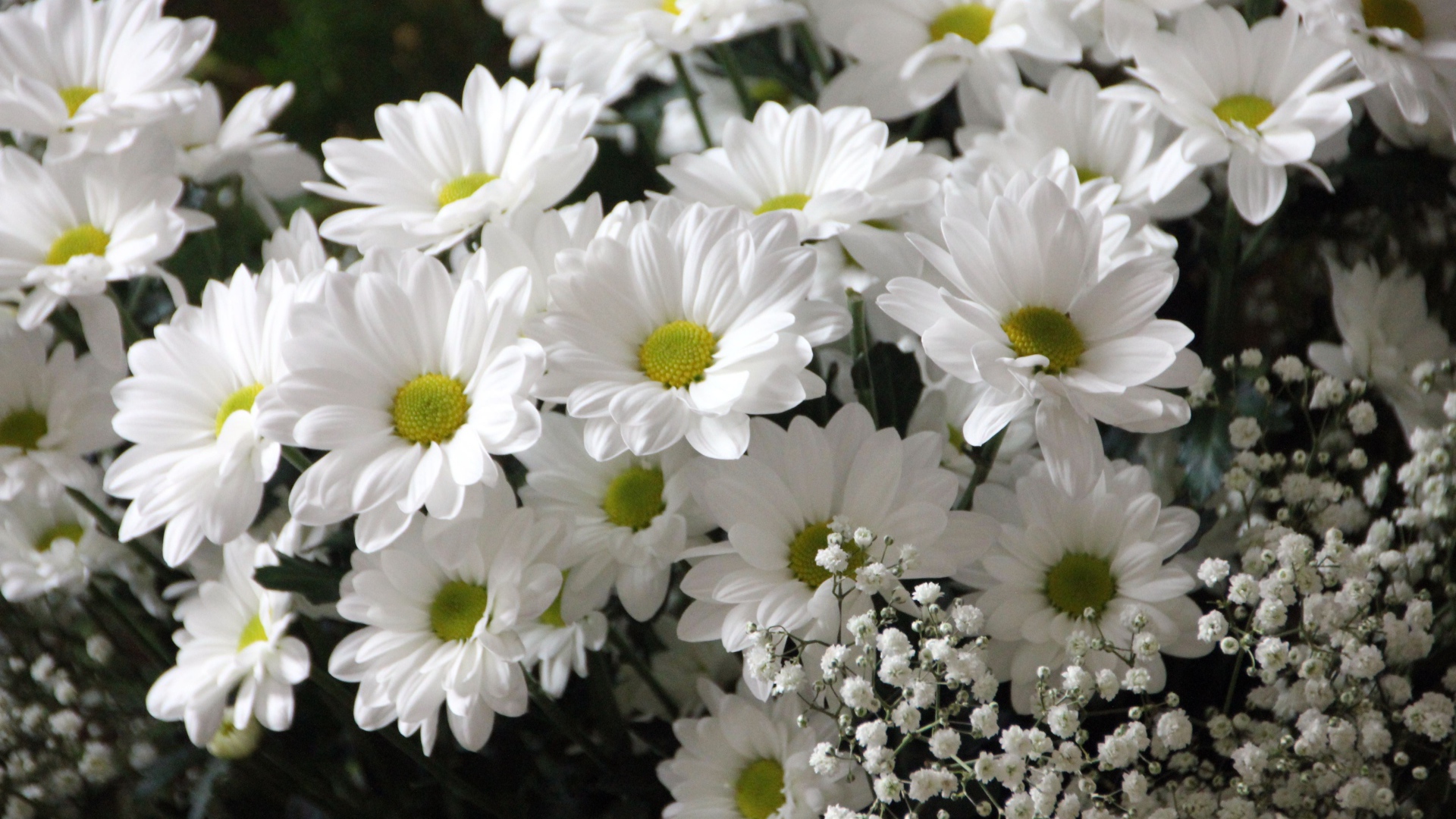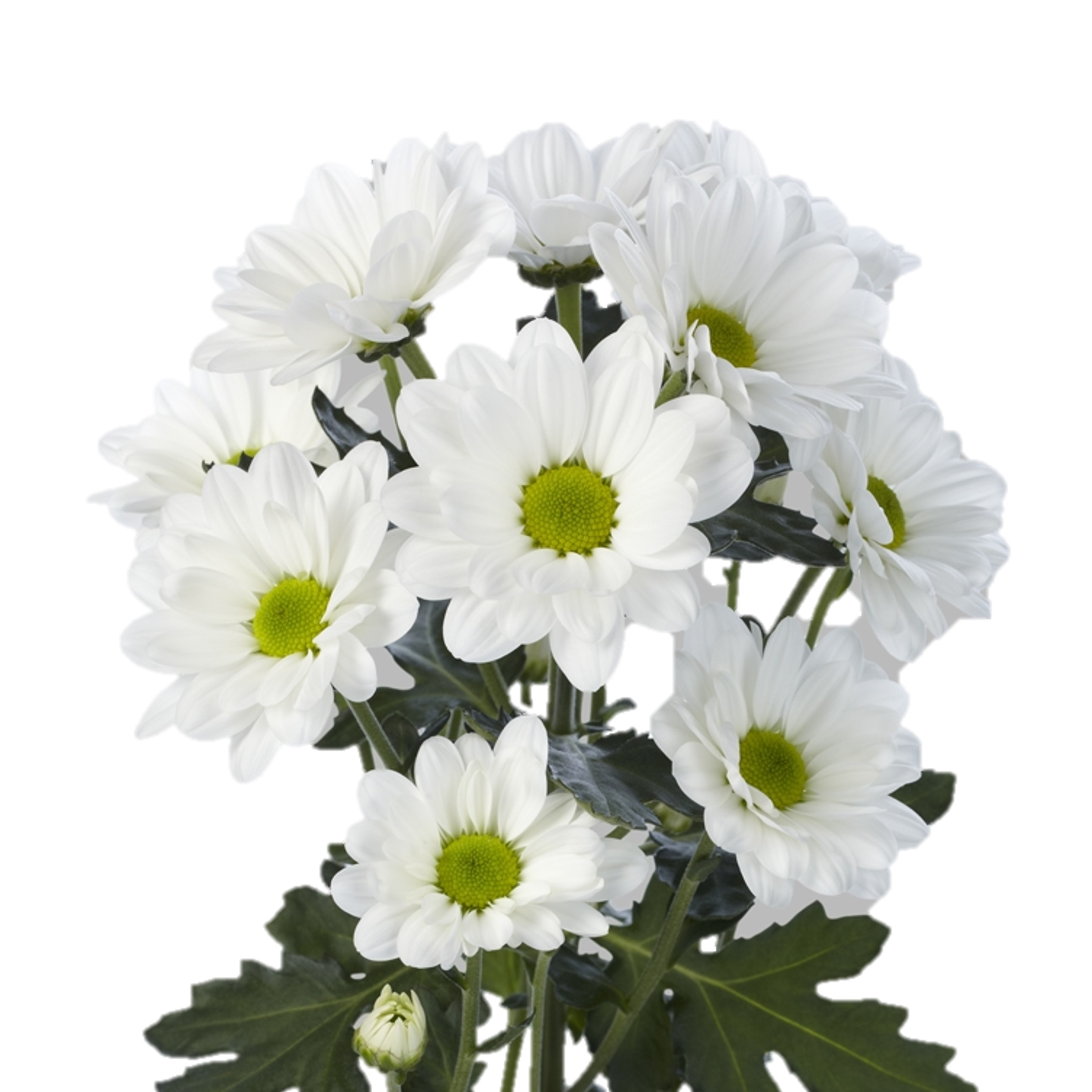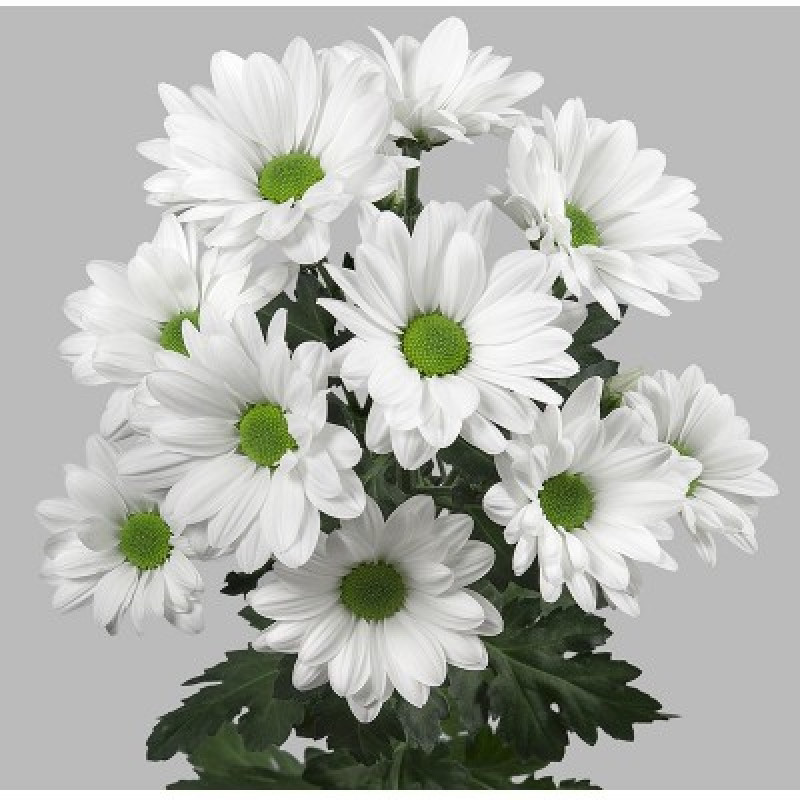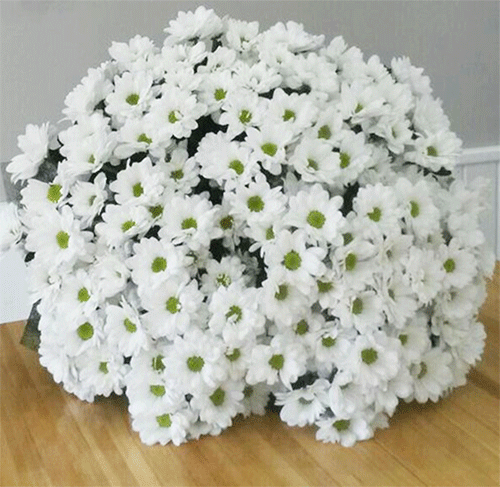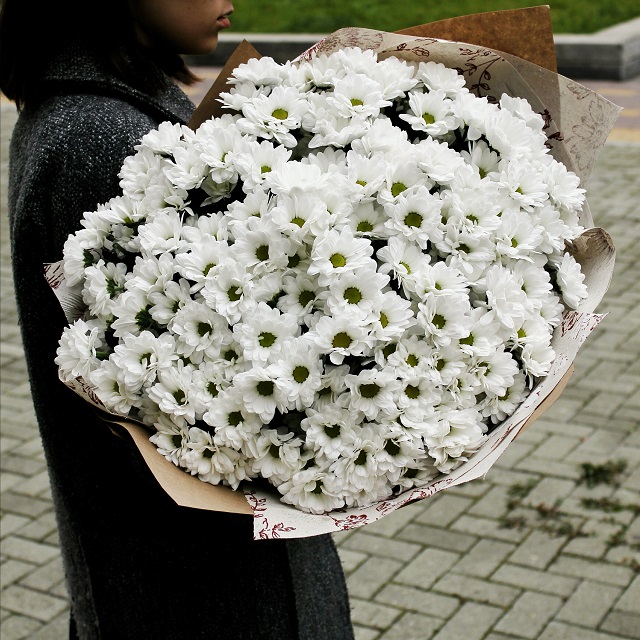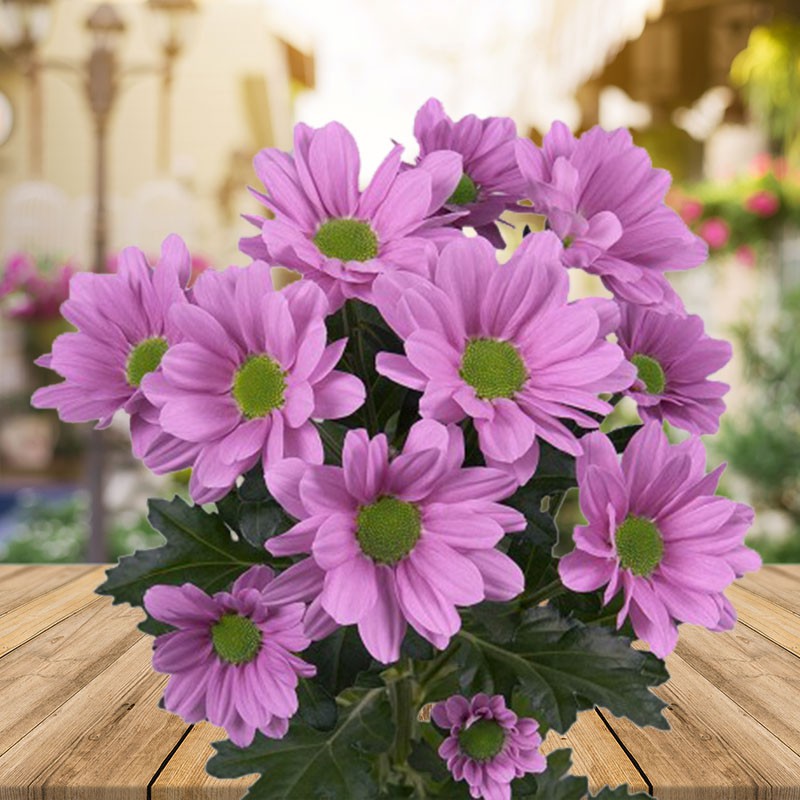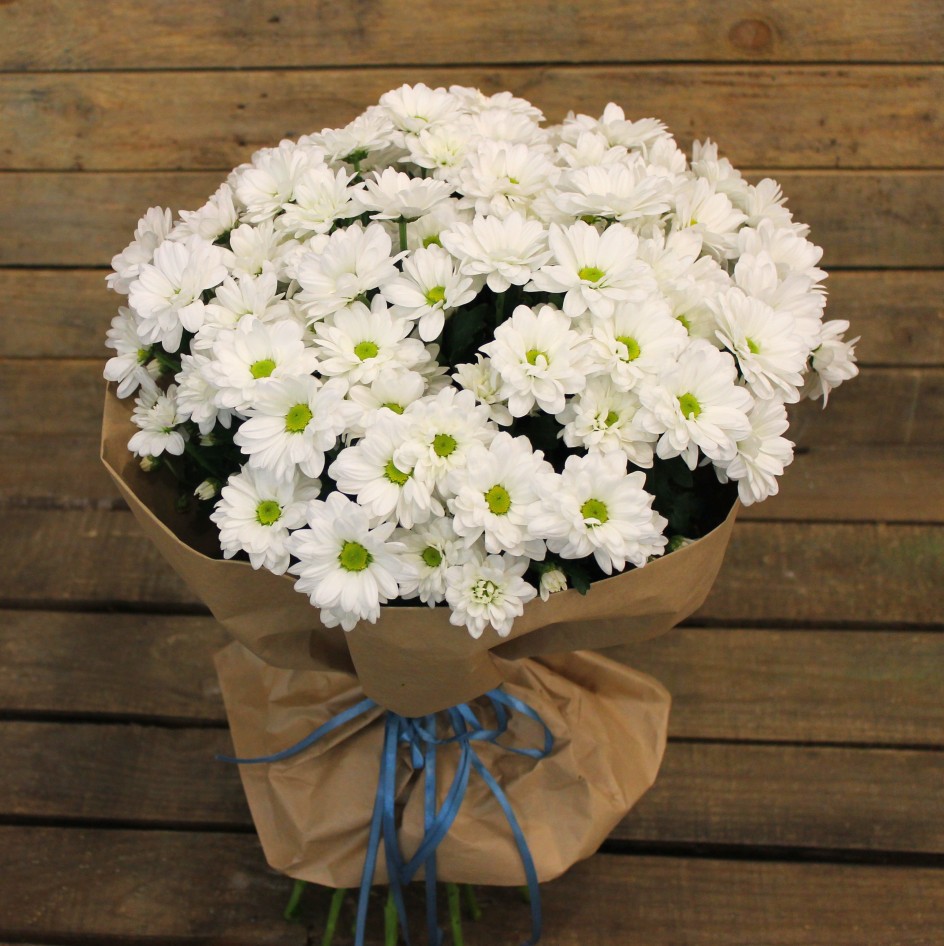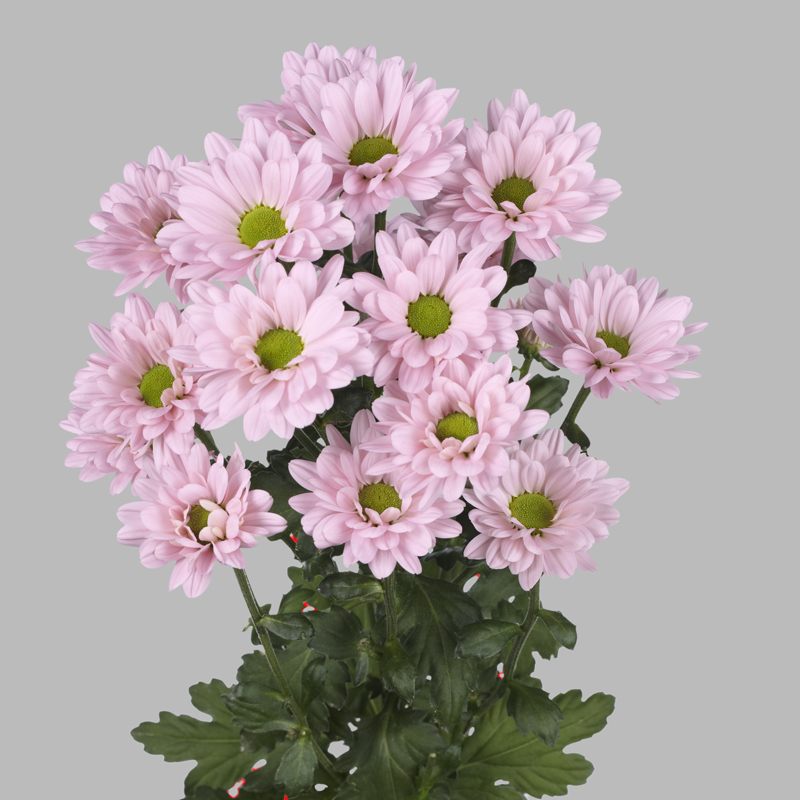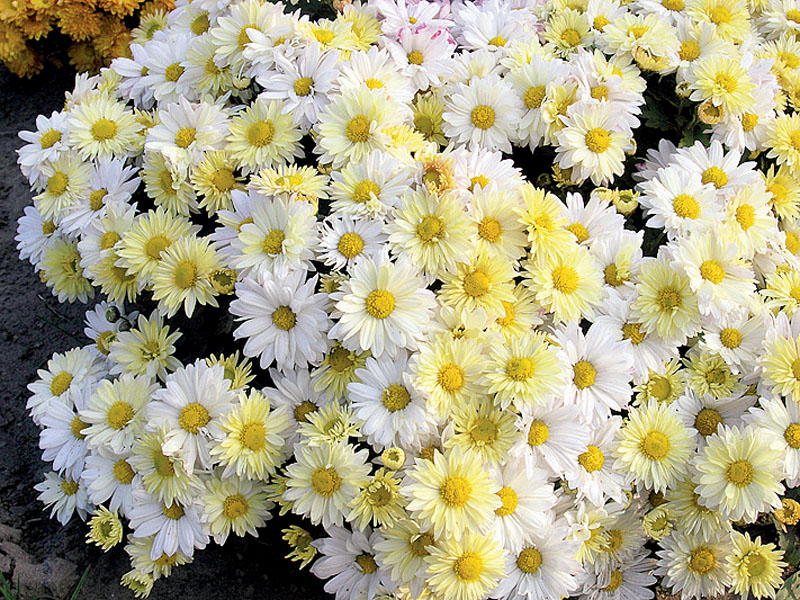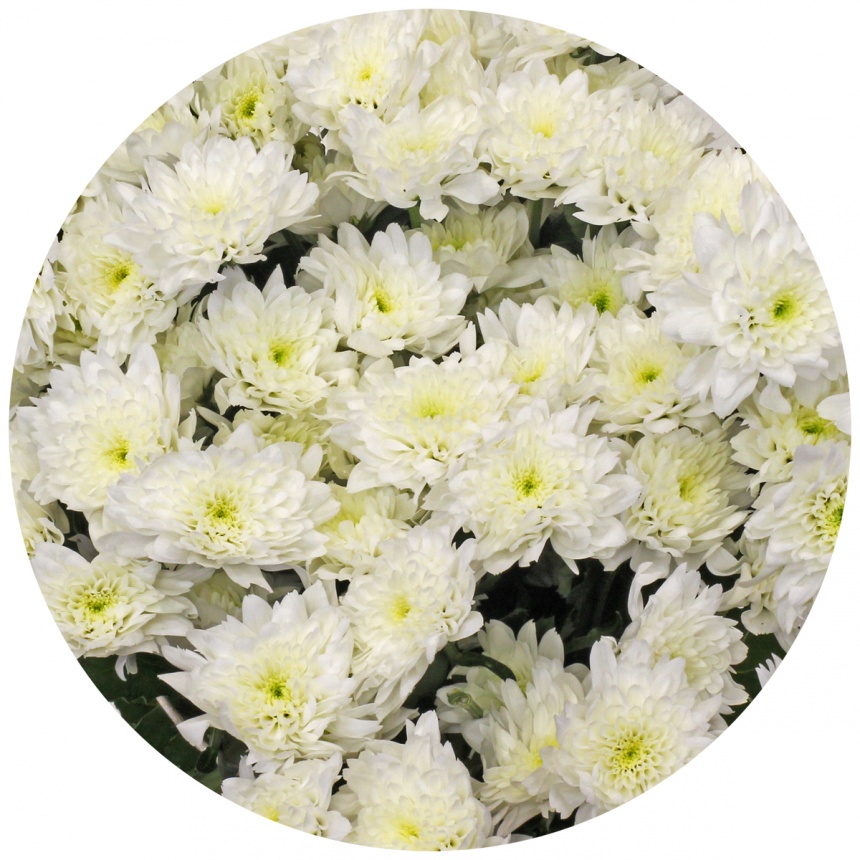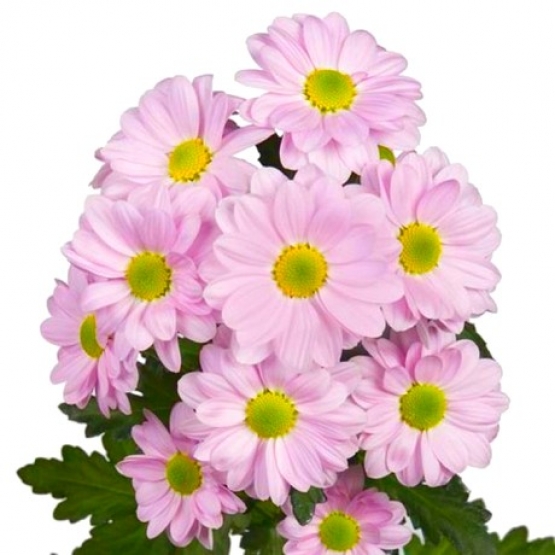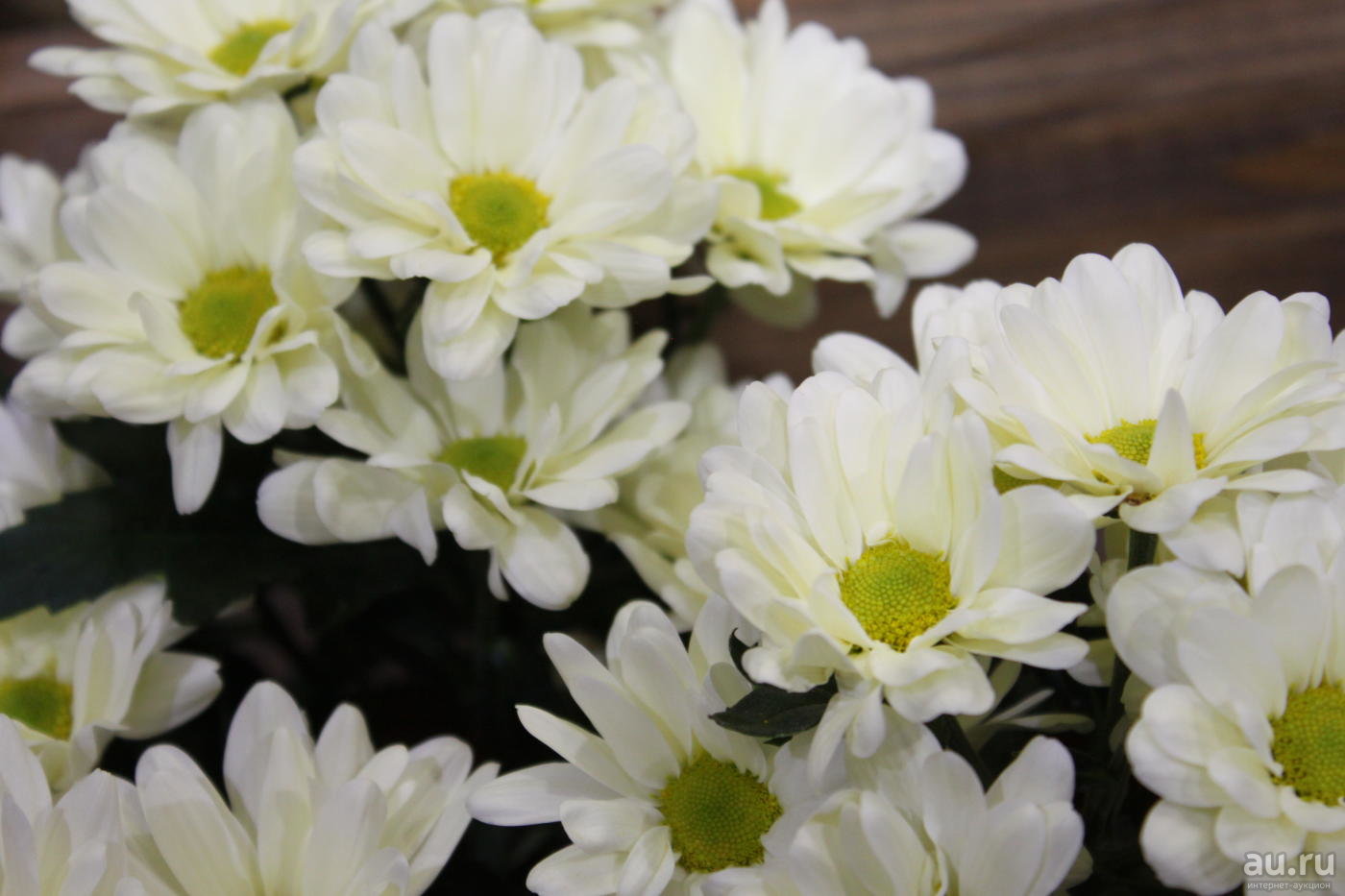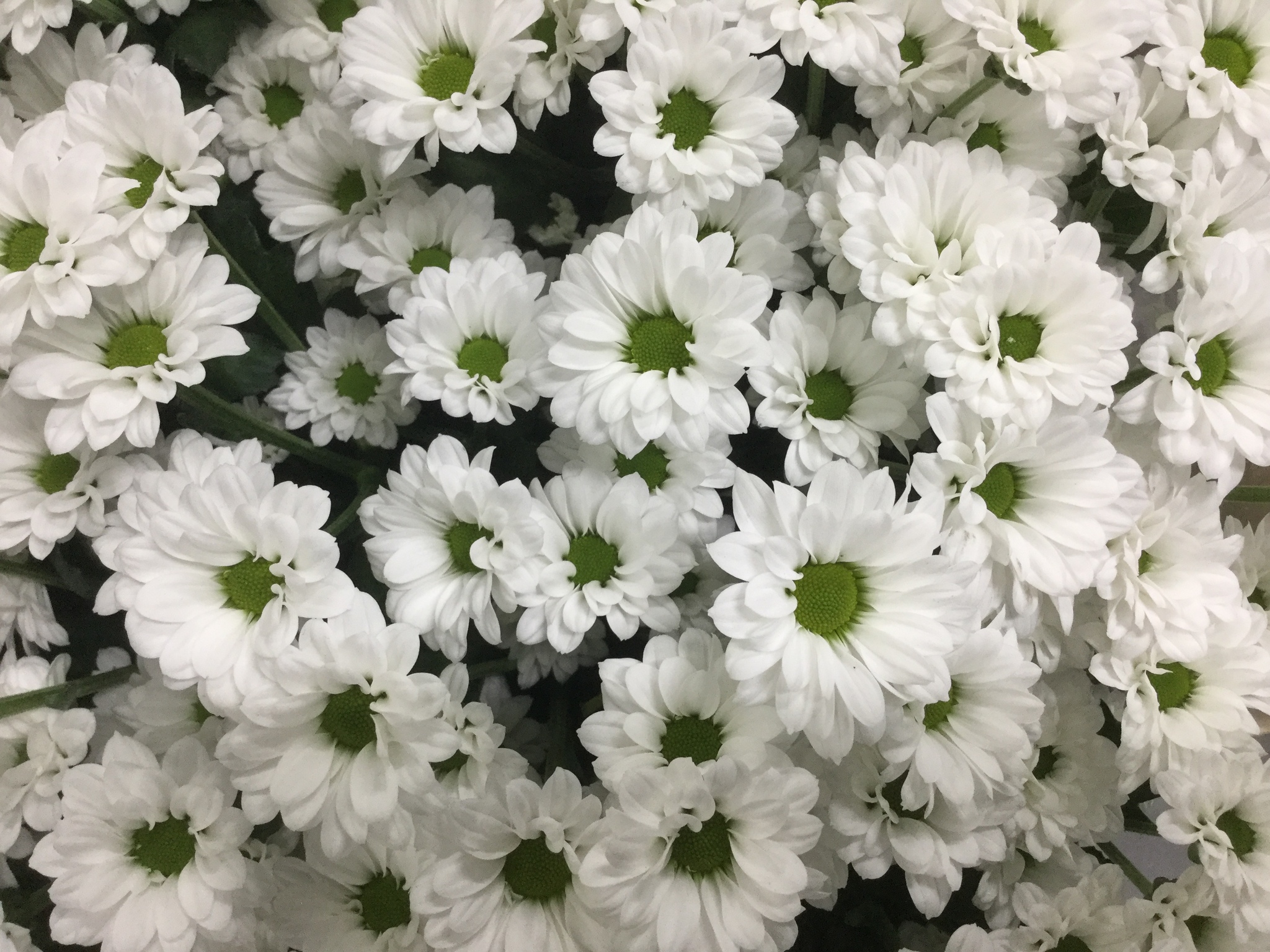Advice
If you plan to plant such a beautiful and vibrant plant at home or on the site, you should take on board some useful tips and tricks for growing it.
Chrysanthemum bushes, which were grown in a greenhouse using the appropriate technology, must also be dug up in late autumn, like large-flowered or hybrid varieties.
It is always necessary to adhere to the agricultural technique of the described culture. Otherwise, whole thickets of chrysanthemums can grow on the site or in flower beds, which dramatically increases the risk of fungal diseases.
In winter, chrysanthemums require special care. If the selected place on the site is low, then it is recommended to dig out grooves-drainages near the flower beds before sheltering the plants. A great danger for chrysanthemums in the winter season is represented by high humidity, an ice layer on leaf blades, and soil freezing. If multilayer shelters are used, they must be removed in a timely manner in the spring.
Carrying out any manipulations with such colors, you must be as careful and careful as possible.
It is important not to damage the roots of the flower. Otherwise, it may not take root in its place and simply die.
If you want to get large upper flowers, you should resort to such a procedure as pinching
To do this, you need to thin out the chrysanthemum buds on the sides.
When feeding chrysanthemums, it is important to ensure that fertilizer solutions never fall on the leaf plates of the flower, and do not lead to burns. You can water the plant exclusively at the root.
Burnt mullein and chicken droppings are good top dressing, but growers need to be very careful - it is better not to feed the flower a little than to burn it with excess fertilizer.
Care must be taken to ensure that chrysanthemums are not overgrown with weeds. They need to be removed in time.
If you plant several chrysanthemum bushes at once, then it is imperative to leave a distance of about 30-50 cm between them. We must not forget that this culture usually grows very much.
If you grow tall, large-flowered flowers on your site, then at a certain point they must be tied to pegs. If this is not done, plants at high altitudes will simply break or fall over.
For watering the considered flowers, it is best to use either settled or rainwater. After each watering, it is advisable to loosen the plants so that a dry crust of the earth does not form.
Large-flowered specimens do not make sense to insulate, since they cannot be left for wintering in the open field. They must be dug up and moved to a separate flesh storage facility until spring.
For information on how to properly plant and care for chrysanthemums, see the next video.
Application in landscape design
Chamomile chrysanthemums look lovely in group and single plantings. A single bush may well decorate a garden lawn.
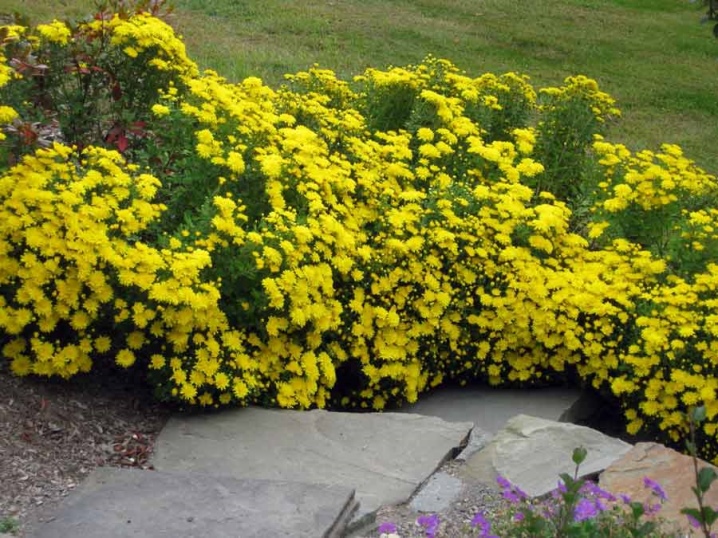
Low-growing bushes look beautiful in compositions around trees, when framing paths and curbs. Perennials harmonize well next to marigolds, zinnia, coleus and balsam. Multicolored chrysanthemums planted on the same flower bed, for example, red and white, will surely attract enthusiastic eyes. Planting chrysanthemums in mixborders also looks advantageous.
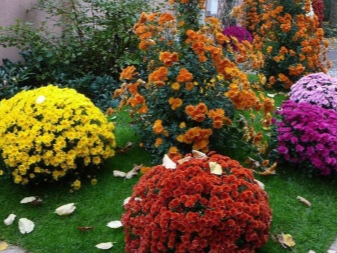

If there are coniferous trees on the site, the bushes will stand out perfectly against their background.
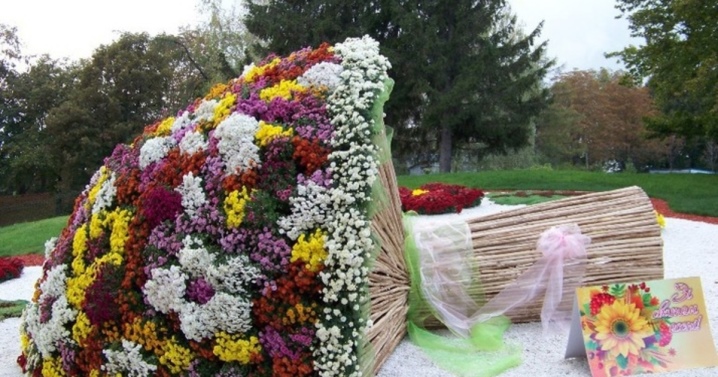
Daisy chrysanthemums will undoubtedly become a wonderful decoration of the garden.

How to get 10 from one chrysanthemum bush, you can see in the video below.
Flowers most similar to daisies
Plants of the genus Pupavka, Nivyanik, Tri-ribbed, Hamamelum, Pyrethrum (popovnik) and some others are most similar to chamomile. All of them have features that make it possible to distinguish them from true daisies, but at first glance, for an uninitiated person, they are typical daisies. Moreover, the places of their growth are similar to those of plants of the genus Matricaria - these are typical field or meadow flowers that grow abundantly in open areas of soil without a dense vegetation cover, but then disappear where tall shade-forming weeds appear.
Let's take a look at a few of these plants and find out how they differ from chamomiles.
In the photo below - odorless tehrebernik, or odorless chamomile:
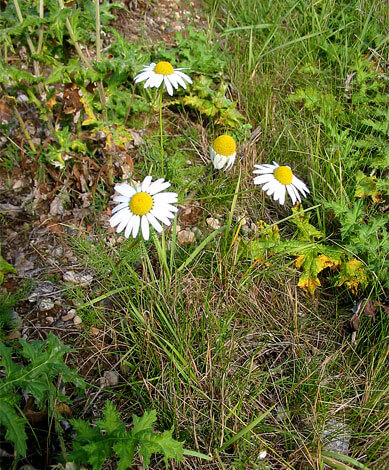
Its main distinguishing feature is the lack of smell in the inflorescences. Chamomile smells very strong compared to it.
An even more unambiguous difference: the absence of a cavity inside the receptacle. In the photo below, on the left - a cut inflorescence of chamomile, and on the right - odorless chamomile:
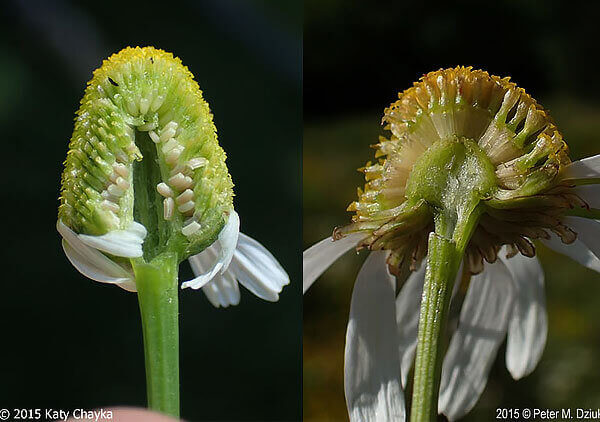
It can be seen that in chamomile the receptacle is hollow, in chamomile it is solid.
Another difference between this plant and chamomile is that the seeds have only three facets. This can be seen in the photo:

Chamomile fruits have much more such ribs:
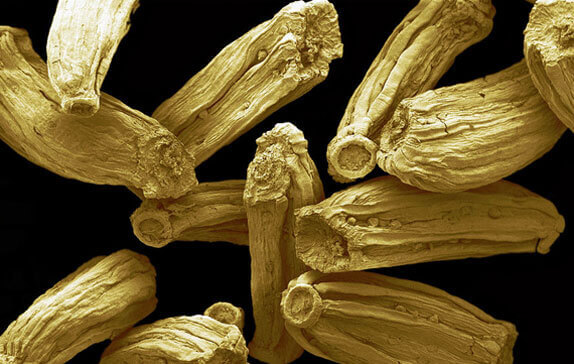
Actually, for this feature, the three-ribbed ones got their name.
Other chamomile-like plants are navel. This genus includes the field navel, the Russian navel, the dog's navel, it is also smelly, and some other species that form low bushes with the same inflorescences as chamomile.
In the photo below is a dog's belly button:
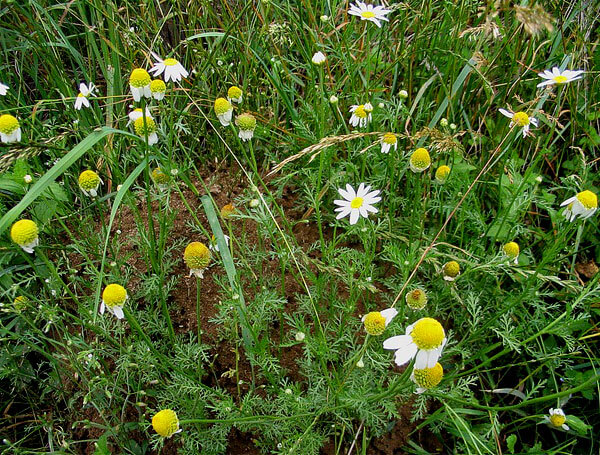
Outwardly, it is easy to confuse it with a pharmacy chamomile, but if you smell its flowers, you immediately catch the difference: the smell of a dog's navel is very unpleasant.
Here is the navel, Anthemis arvensis:
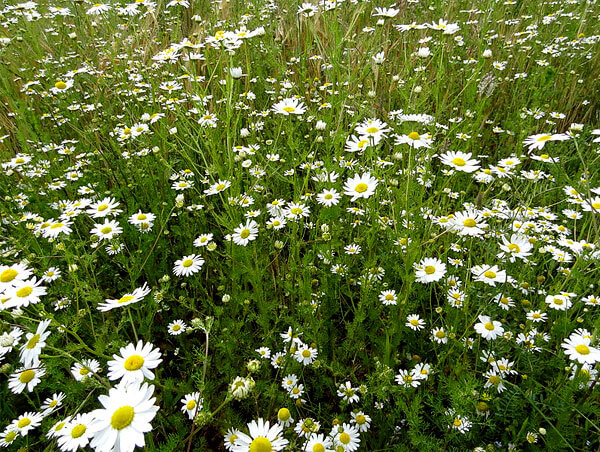
All umbilicals differ from true daisies by the absence of a cavity in the receptacle.
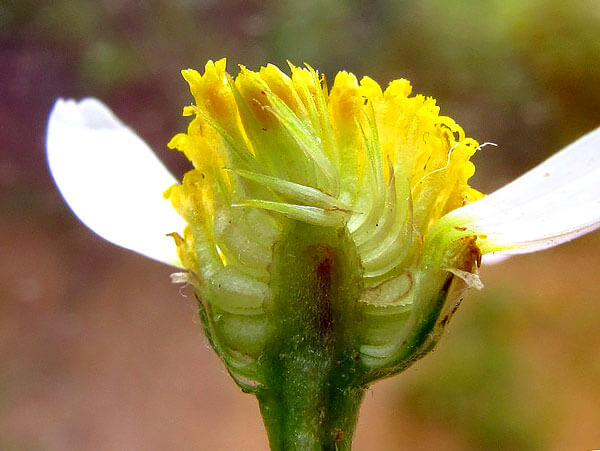
Section of the inflorescence of Russian chamomile.
Daisies are very similar to chamomiles - they are also mainly annuals growing in open spaces. The photo below shows an ordinary daisy, or a popovnik:
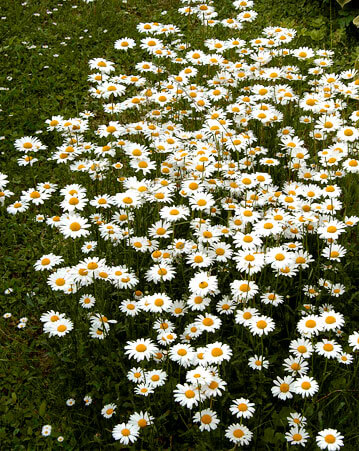
Its inflorescences are somewhat larger than chamomile inflorescences. If in the latter the inflorescence has a diameter of 15-25 mm, then in the daisy its average size is 40-60 mm.

The inflorescence of the daisy will not fit on the thumbnail, like the inflorescence of chamomile.
Another genus of plants very similar to typical chamomiles is Hamamelum. It includes two types of plants, the most famous of which is Roman chamomile. It is very widely used as a medicinal plant in folk medicine, and in the European pharmacopoeias it is no less significant than pharmaceutical chamomile. Its inflorescences are also very similar to the inflorescences of chamomile:
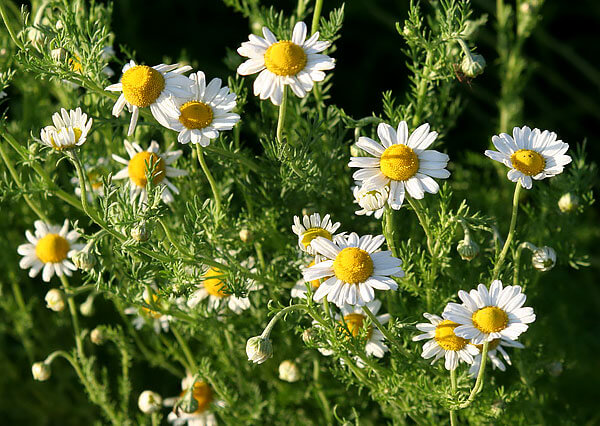
But they do not have an empty cavity in the receptacle, and the structure of the vegetative part of the plant differs from that of typical chamomiles.
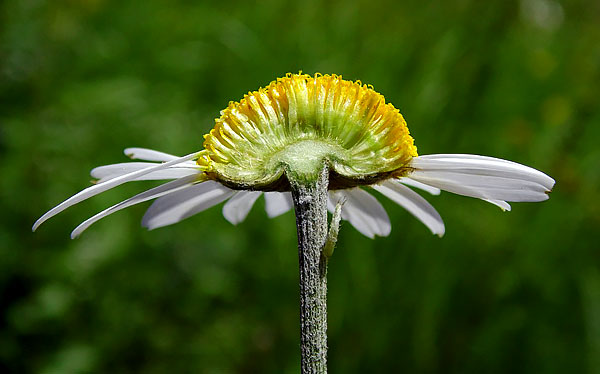
In particular, Roman chamomile has significantly thicker and denser leaves.
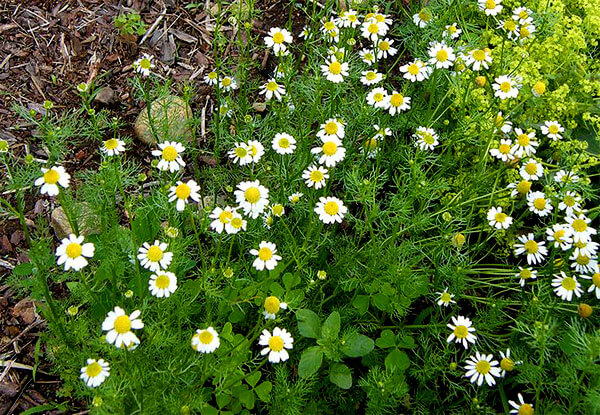
Finally, the flowers, very similar to chamomile, belong to the genus pyrethrum. In particular, this is pyrethrum scutellum (aka scutellum tansy):

... and maiden tansy:

It is noteworthy that in maiden tansy, individual subspecies have double inflorescences, well distinguishable from the inflorescences of chamomile. They are also called "fluffy". Small flowers of a typical form strongly resemble chamomile and are often called so. It is noteworthy that tansy also has pronounced medicinal properties, but in general it is used in medicine less often than pharmaceutical chamomile.
The plants listed above are so similar to chamomile that it is easier to confuse them with it than to distinguish from it. At the same time, hundreds of other plants are known that are called chamomiles and are considered as such, but which, in reality, are not chamomiles and are very easily distinguished from them.
Popular varieties
Planting and growing this bush flower will not require much effort from you.But before buying seedlings, be sure to consider which varieties of chrysanthemums with chamomile-like buds you can plant on your own plot. A lot of them have been bred by modern breeders.
Ariel

The chrysanthemum of the Ariel variety is distinguished by its semi-double inflorescences. It blooms from July to September. The foliage has a rich dark green hue. This feature contrasts perfectly with the bright, light buds. This plant has quite abundant flowering. Ariel will look great in bush compositions.
This chrysanthemum is often used to decorate borders, country-style flower beds. Many people root such flowers for cutting. Be sure to moisturize and drain the soil where Ariel's chamomile chrysanthemum is rooted. In general, the plant is considered unpretentious, but loves bright lighting.
Isabel

The inflorescences of this chamomile plant are also semi-double, have a lilac color, close to pink. The shrub is upright, reaches a height of about 60–70 cm. You cannot do without a garter of the stems if you do not want them to spread along the ground. The buds of the Isabelle variety bloom in mid-August, and the shrub blooms until October. With the onset of cold weather, it is recommended to sprinkle it with leaves, spruce branches or oak branches.
Kibalchish boy
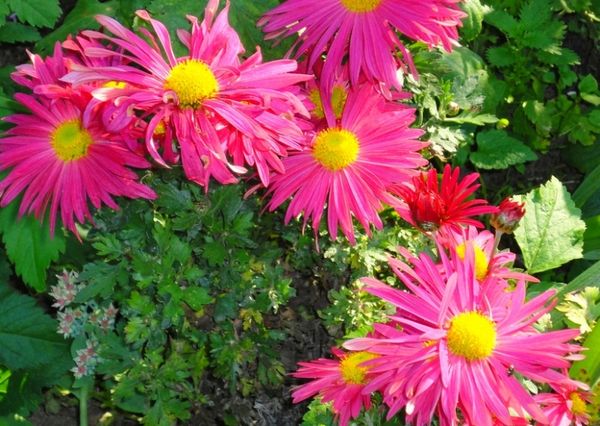
This variety belongs to the Korean varieties of chamomile chrysanthemum. The bush is no more than 28 cm high. It is not covered with foliage too densely, but it blooms quite abundantly. The buds are single-row, not lush, have a pink-purple hue. The flowering phase lasts about a month. In this case, all the buds are concentrated, as a rule, on one stem, that is, no shoots arise. If you want to get large flowers, be sure to worry about grafting the plant with the onset of summer.
Evening lights
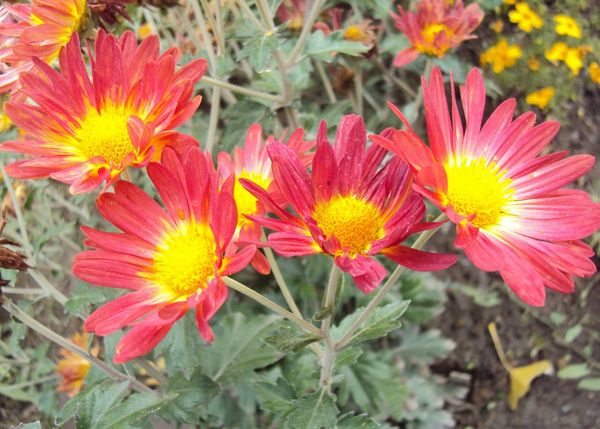
This shrub is considered miniature. Its stems reach about 35 cm in height. The inflorescences of the Chrysanthemum variety Evening Lights are bright red, their diameter is no more than 5 cm. This variety of chrysanthemum blooms profusely, but practically does not form root shoots. The flowering phase lasts about a month.
Alyonushka
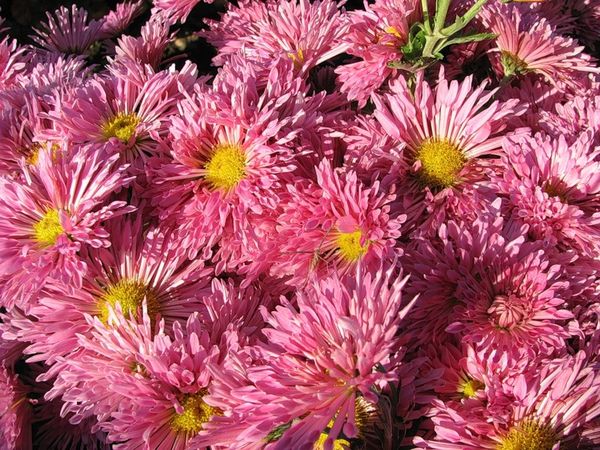
Among the tall varieties of chamomile chrysanthemum, it is worth highlighting a species called Alyonushka. The shrub reaches a height of about 50 cm. Its inflorescences are non-double, have a bright pink hue. The diameter of one flower will be no more than 5 cm. As a rule, flowering is observed already in September.
Caring for such a chamomile flower does not differ in particular difficulties. Plant it in well-lit areas and remember to irrigate the substrate regularly. Another key point: loosening the soil. Follow these guidelines and the plant will delight you with its chamomile buds for several years.
Hebe

Such a shrub is primarily distinguished by its compact size. It reaches a height of about 55–65 cm. Its inflorescences are single-row, their diameter is 5 cm. The buds bloom in mid-October. In general, the flowering phase of this chamomile shrub continues until the onset of frost. Such a plant does not bear fruit.
Green lizard, Ariel, Isabel, Malchish-kibalchish - no matter what kind of chrysanthemum you like (tall or short, with small or large flowers), you should try to germinate seeds in your own garden plot. You will be satisfied with the beautiful buds and ease of caring for the plant.
The use of chamomile chrysanthemums in landscape design and in bouquets

These perennials can be successfully grown in flower beds, on indoor and outdoor terraces, as well as on balconies and indoors. Due to the color variety of petals, chamomile chrysanthemum is a welcome guest in flower beds. With its help, you can create many spectacular compositions, decorate borders.Chamomile chrysanthemums look especially beautiful on country-style areas.
Chamomile bush chrysanthemums are prized for their versatility and unpretentiousness, as well as their long flowering period. They are perfectly combined with other plants of the Aster family, look beautiful against the background of ornamental garden shrubs and conifers: juniper, hydrangea, barberry, thuja.
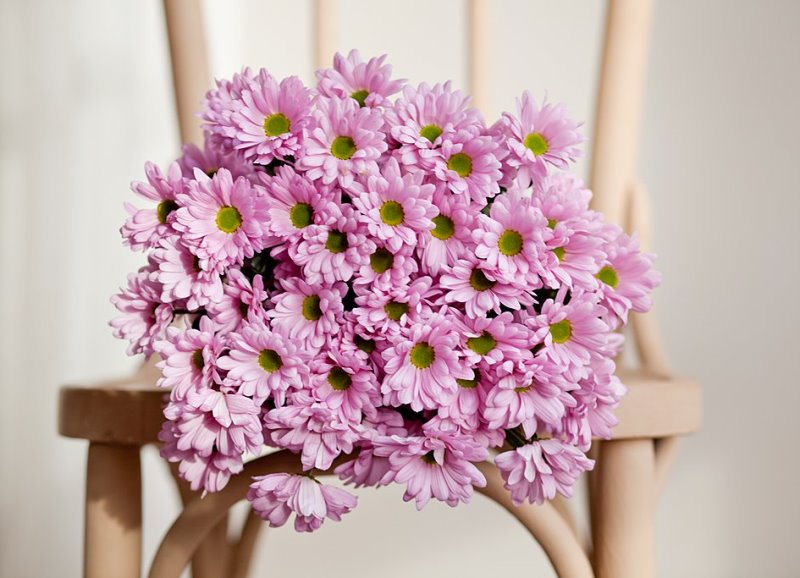 Bouquet of pink chamomile chrysanthemums
Bouquet of pink chamomile chrysanthemums
In the cut of chrysanthemums in the form of chamomile, they feel great. Florists often use cut flowers to create colorful bouquets, flower arrangements, to decorate wedding ceremonies, flower baskets.
Types of daisies - flowering border perennials
To date, the classification of chamomiles has more than 25 varieties of this cute flower: from the pharmacy chamomile, known to everyone, to the original blue chamomile, the petals of which, as the name implies, can have unique shades - from sky blue to deep blue.
Perennial blue chamomile
Chamomile - perennial or annual
Depending on the variety, chamomile can be either annual or perennial. For example, the garden species Banana Cream and Snow Maiden are perennial varieties, while chamomile is an annual plant.
Description of colors
Chamomile (in Latin "Matricária" - "uterine herb") is an amazing in its simplicity flower belonging to the Asteraceae or Asteraceae family.
Chamomiles are semi-double and double, their petals may differ from each other: there are flowers with thin and wide, curved and straight. Moreover, varieties have been bred that have no petals at all. Some varieties have a slight odor, while others do not smell at all.
For your information! Many growers are wondering how many petals a chamomile has. There is no exact answer to this question, the whole point is that each flower is individual, and the number of petals, even within one variety, can vary from 10 to 34 pcs.
The information on where daisies grow deserves special attention. Thanks to the small seeds, which the wind can blow over long enough distances, neat meadows or single bushes can be seen all over the world, pleasing to the eye with their simplicity. Another important factor that allows daisies to feel equally good both in Africa and the USA, as in Australia and Eurasia, is their unpretentiousness and ability to quickly adapt to a wide variety of climate conditions.
Classic chamomile has white petals
Novice flower growers often wonder when field daisies bloom. Flowering begins in the second half of April, the entire warm period lasts and ends in September along with the onset of cold weather. Most of the flowers are revealed in the summer, during June and July. However, in regions where the climate is mild and warm, for example, in the Caucasus, in the Crimea and the Mediterranean, daisies bloom quite early, you can admire them already at the end of February.
Note! Each bush releases more and more inflorescences during the summer months, making it seem that the flowering is continuous. The most popular representative of the family is field chamomile, which has a number of useful qualities.
So, scientists specializing in such a science as pharmacognosy, managed to find out that the essential oil that is part of the inflorescences has antiseptic and disinfectant properties, has a beneficial effect on mucous membranes. Speaking about the beneficial properties of chamomile, one cannot fail to mention vitamins and minerals that can strengthen and nourish hair, giving it shine and a healthy look.
The most popular representative of the family is field chamomile, which has a number of useful qualities.So, scientists specializing in such a science as pharmacognosy, managed to find out that the essential oil that is part of the inflorescences has antiseptic and disinfectant properties, has a beneficial effect on mucous membranes. Speaking of the beneficial properties of chamomile, one cannot fail to mention vitamins and minerals that can strengthen and nourish hair, giving it a shine and healthy look.
Dry flowers to collect
Important! The components that make up the chamomile collection help get rid of colds, improve the functioning of the gastrointestinal tract, eliminate redness and flaking, and can cure itching. It is not surprising that gardeners from all over the world plant unpretentious plants on their plots.
Listed below are the most attractive varieties of daisies that will adorn any, even the smallest garden plot.
It is not surprising that gardeners from all over the world plant unpretentious plants on their plots. Listed below are the most attractive varieties of daisies that will adorn any, even the smallest, garden plot.
Popular varieties and hybrids
Breeders have bred many colorful varieties of chamomile chrysanthemums, which are versatile and used in various garden decorations. Using plants of different colors and shapes, you can create a colorful and unique combination in your flower garden.
Before you start growing these flowers, you must familiarize yourself with the detailed description of the varieties and the care requirements.
- Inga. Shrub Korean chamomile variety with dark yellow anemic inflorescences. The marginal petals are ligulate, long; the medullary petals are tubular. Plant height reaches 70 cm, erect shoots, slightly leafy. The leaf plate is elongated, pinnate at the edges.
- Camila. Shrub, semi-double type with small flowers in a circle of 4-5 cm with a yellow core and white marginal petals. This variety most of all resembles chamomile in appearance. Cut flowers can stand for about a week.
- White Lacemaker. Non-double autumn chrysanthemum of Korean selection with long white spoon-shaped petals and a bright yellow core, consisting of small tubular petals. The height of the bush varies from 55 to 75 cm. Shoots are straight, light green, leaves are dissected, elongated. The inflorescences of the Belaya Kruzhevnitsa variety are not too large - with a diameter of 7-8 cm. Flowering occurs in the last decade of October.
- Proseco. The bush-shaped bush is densely covered with delicate small flowers. The marginal petals of the buds are white, ligulate, light green closer to the core. In the center of the flower there is a dense disc of small tubular flowers of a bright green hue. The diameter of the inflorescences is 5-6 cm. The plant is grown for cutting, since it does not lose its decorative qualities for two weeks.
- Chrysanthemum Pink chamomile is a compact shrub, about 1 m high with straight, thin, slightly leafy stems. Leaves are elongated, dissected along the edge. Inflorescences are two-colored - the core is yellow, round from small tubular petals, bordered with long petals of a bright pink tone. The diameter of the inflorescences of the Pink Chamomile chrysanthemum is 4-6 cm. This is one of the longest-flowering varieties - buds bloom in early September and crumble in late autumn, after the first frost.
- Chrysanthemum Red chamomile. A tall tree-like plant about 1 m high. It blooms with bright flowers, about 5-6 cm in diameter. The inflorescences consist of a yellow core and scarlet petals along the edge. Flowering occurs in the first decade of September.
- Malchish-Kibalchish. Dwarf chamomile species - maximum height 28-30 cm. Medium-sized inflorescences - about 7 cm. Flowering occurs in mid-August.Flower buds consist of a dense, bright yellow core and lilac or purple petals arranged in one row along the edge.

Chrysanthemum Red Chamomile


